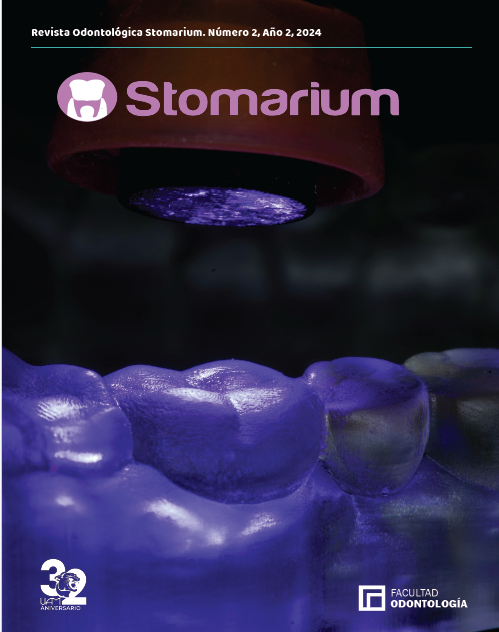Comparison of the Survival Rate of Two High-Viscosity Glass Ionomer Cements in Class II Cavities Using the Atraumatic Restorative Technique – Faculty of Dentistry, UAM (March 2023 - May 2024)
DOI:
https://doi.org/10.62407/ros.v2i2.174Keywords:
Atraumatic restorative treatment, dentistry, minimally invasive procedures, deciduos dentition, glass ionomer cements, non cooperative patientAbstract
The aim of this study is to evaluate the survival rate of restorations made with two high-viscosity glass ionomer cements (Fuji IX, GC and Ketac Molar Easy Mix, 3M) applied as a restorative material using the atraumatic restorative technique (ART) in Class II cavities of primary molars, assessed five months after placement. The research is experimental and quantitative in nature. The initial sample consisted of 22 pediatric patients with 27 Class II cavities to be treated, aged between 5 and 9 years, with active carious lesions located on the proximal surfaces of primary molars. However, the final sample included 19 patients with a total of 25 restorations. Clinical diagnosis was performed using the international caries detection and assessment system ICDAS. For the assessment of glass ionomer restorations, the criteria of Frencken and Holmgren were applied. For statistical analysis, Chi-square tests, Relative Risk, and Odds Ratio were used. From the aforementioned tests, it is concluded that the risk of achieving a “satisfactory” outcome is slightly higher when using Fuji IX, GC compared to Ketac Molar, 3M. Although the statistical analysis suggests that the risk of obtaining a satisfactory result is slightly greater for Fuji IX, GC compared to Ketac Molar, 3M, the observed differences are not statistically significant.
Downloads
References
Călin, D.L.(2022). Assessment of Atraumatic Restorative Treatment in Anxious Patients. Revista Română de Anatomie funcţională şi clinică, macro- şi microscopică şi de Antropologie. Vol. XXI – Nr. 4. pp 209- 216. https://revanatomie.ro/ro/abstract.php?an_rev=2022&nr_rev=4&nr_art=3
Campos, F., Rodriguez, M. A., Durand-Herrera, D., Sakalian, C., Uribe Echevarría, J., & Rodriguez, I. A. (2017). Análisis de biocompatibilidad de cementos ionómero de vidrio de alta viscosidad. Actualidad Médica, 102(802), 151-155. https://doi.org/10.15568/am.2017.802.or04
Caso Guerra, R. M., & Campos, K. J. (2021). Propiedades y aplicación clínica de los ionómeros de vidrio de alta densidad disponibles en Lima-Perú. Odontología Sanmarquina, 24(4), 351–356. https://doi.org/10.15381/os.v24i4.19854
Da Mata, C., Allen, P. F., Mackenna, G., Hayes, M., & Cronin, M. (2015). Two-year survival of ART restorations placed in elderly patients: A randomized controlled clinical trial. Journal of Dentistry, 43(7), 736-741. https://doi.org/10.1016/j.jdent.2015.03.012
De Amorim, R. G., Leal, S. C., Mulder, J., Creugers, N. H., & Frencken, J. E. (2012). Amalgam and ART restorations in children: A controlled clinical trial. Clinical Oral Investigations, 16(1), 267-273. https://doi.org/10.1007/s00784-011-0520-6
Flores. (2010). Técnica de Restauración Atraumática. [Universidad Nacional Mayor de San Marcos Facultad De Odontología, Lima Perú. Trabajo de investigación, pp. 1 - 45]
Frencken, J. E., & Van Amerongen, W. E. (1999). ART: Atraumatic restorative treatment for dental caries. STI Book Publishing.
Frencken, J. E., Van’t Hof, M. A., Taifour, D., & Al-Zaher, I. (2007). Effectiveness of the ART approach in a controlled clinical trial after 6.3 years. Journal of Dental Research, 86(8), 646-649. https://doi.org/10.1177/154405910708600805
Garbim, J. R., Laux, C. M., Tedesco, T. K., Braga, M. M., & Raggio, D. P. (2021). Atraumatic restorative treatment restorations performed in different settings: Systematic review and metaanalysis. Australian Dental Journal, 66(4), 430–443. https://doi.org/10.1111/adj.12871
Leal, S., Bonifacio, C., Raggio, D., & Frencken, J. (2018). Atraumatic Restorative Treatment: Restorative Component. En F. Schwendicke, J. Frencken, & N. Innes (Eds.)(Vol. 27) https://doi.org/10.1159/000487836
Lo, E. C., Holmgren, C. J., Hu, D., & van Palenstein Helderman, W. H. (2007). Six-year follow-up of atraumatic restorative treatment restorations placed in Chinese school children. Community Dentistry and Oral Epidemiology, 35(5), 387-392. https://doi.org/10.1111/j.1600-0528.2006.00352.x
Medina, K.L., Colchado, J.r., Vicuña, L.A., Álvarez, E.O. (2021)Tratamiento restaurador atraumático: Eficacia clínica de ionómeros de vidrio en cavidades clase I. Revista Killkana Salud y Bienestar, (5)1, pp. 61 -71.
Menne-Happ, U., Ilie, N. (2014). Effect of heat application on the mechanical behaviour of glass ionomer cements. Clinical Oral Investigation 18, 643–650 https://doi.org/10.1007/s00784-013-1005-4
Mousavinasab, S. M., & Meyers, I. (2009). Fluoride Release by Glass Ionomer Cements, Compomer and Giomer. Dental Research Journal; 6(2): 75–81. https://pubmed.ncbi.nlm.nih.gov/21528035/
Rodrigues, G. F., Costa, T. D. C., Massa, G. D. S., Vollú, A. L., Barja-Fidalgo, F., & Fonseca-Gonçalves, A. (2020). Oral Health-Related Quality of Life in Preschool Children After Silver Diamine Fluoride Versus Atraumatic Restorative Treatments. Pediatric dentistry, 42(5), 373–379. https://www.ingentaconnect.com/contentone/aapd/pd/2020/00000042/00000005/art00008
Ricketts, D., Lamont, T., Innes, N. P., Kidd, E., & Clarkson, J. E. (2013). Operative caries management in adults and children. Cochrane Database of Systematic Reviews, (3), CD003808. https://doi.org/10.1002/14651858.CD003808.pub3
Saber, A., El-Housseiny, A., & Alamoudi, N. (2019). Atraumatic Restorative Treatment and Interim Therapeutic Restoration: A Review of the Literature. Dentistry Journal, 7(1), 28. https://doi.org/10.3390/dj7010028
Vollú, A. L., Rodrigues, G. F., Teixeira, R. V. R. R., Cruz, L. R., Massa, G. dos S., Moreira, J. P. de L., Luiz, R. R., Barja-Fidalgo, F., & Fonseca-Gonçalves, A. (2019). Efficacy of 30% silver diamine fluoride compared to atraumatic restorative treatment on dentine caries arrestment in primary molars of preschool children: A 12-months parallel randomized controlled clinical trial. Journal of Dentistry, 88, 103-109. https://doi.org/10.1016/j.jdent.2019.07.003
Downloads
Published
Issue
Section
License
Copyright (c) 2025 Stomarium Dental Journal

This work is licensed under a Creative Commons Attribution-NonCommercial-ShareAlike 4.0 International License.





